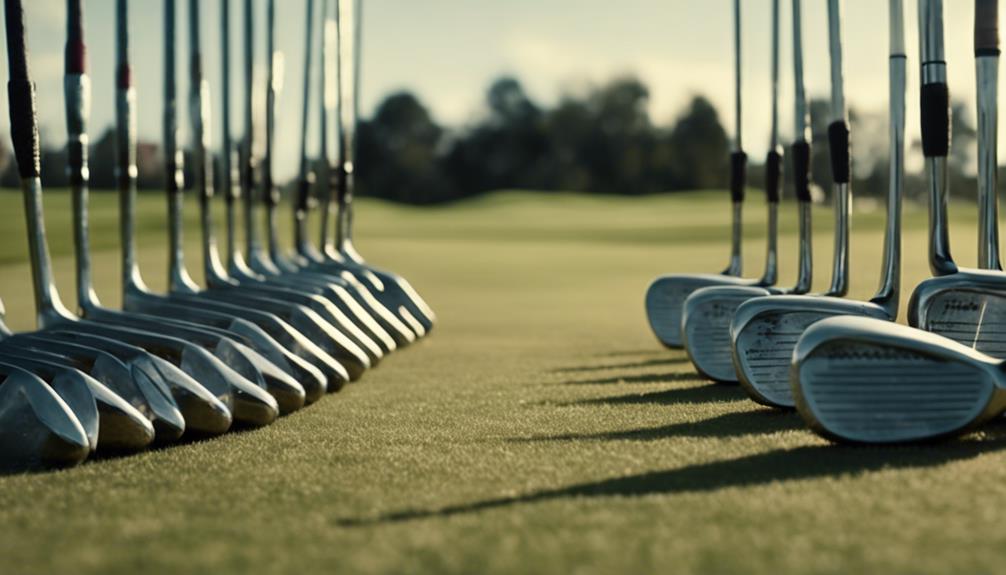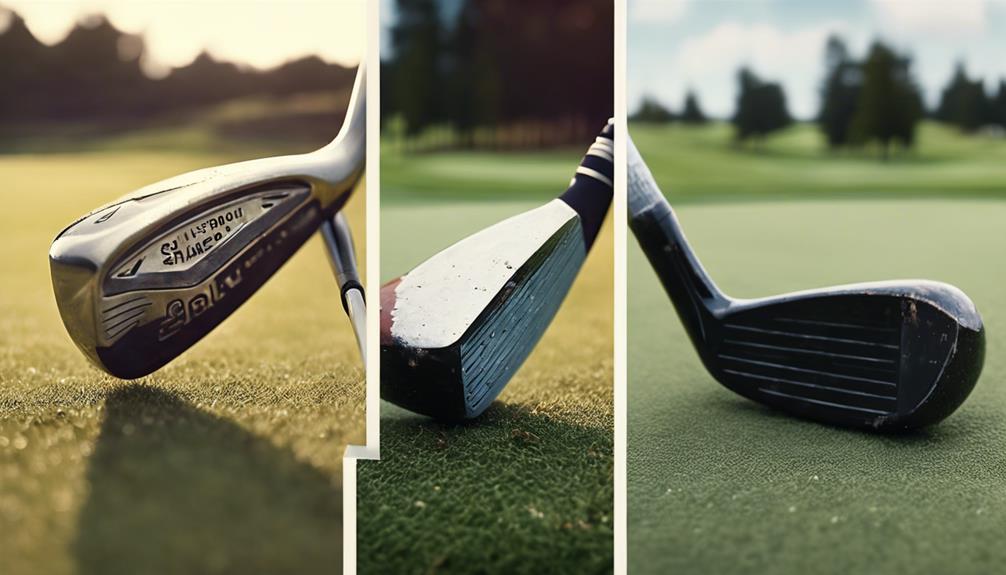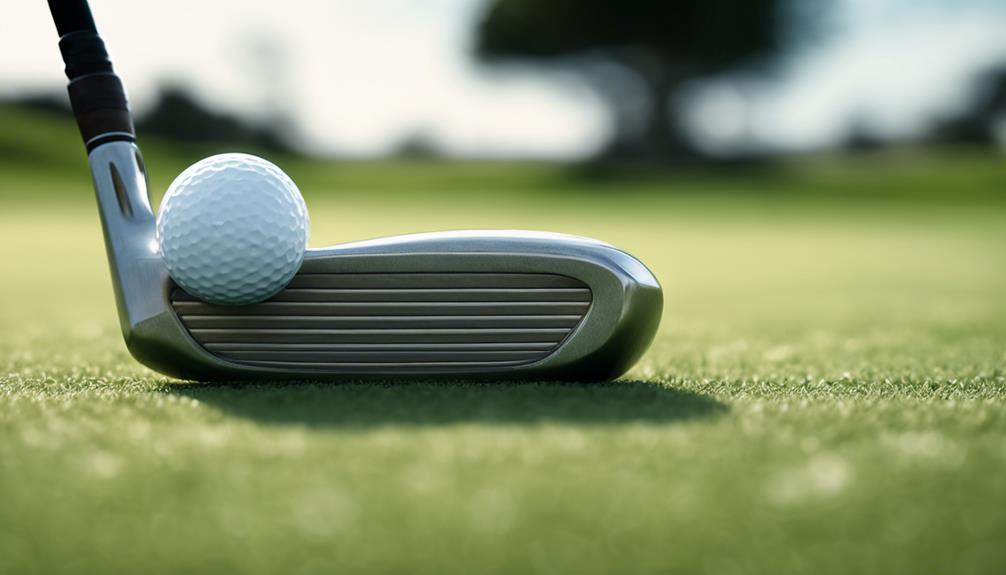- 7 Top Flite Golf Clubs XL for Improved Performance - September 28, 2024
- Top Flite Golf Clubs: Top 5 Reasons to Choose Them - September 28, 2024
- Top 3 Golf Club Fitters for a Perfect Swing - September 28, 2024
You can expect your golf clubs to have a limited lifespan, ranging from a few years to over a decade, depending on factors like usage, quality, and maintenance. Drivers typically last around 3-10 years, while irons can go for 10 years or 300 rounds. Proper care and storage can greatly prolong your clubs' life, but even with maintenance, signs of wear and tear will eventually appear. If you're noticing declining performance or visible damage, it may be time to think about replacing or upgrading your set. Want to know more about maximizing your clubs' lifespan and performance?
Key Takeaways
- Yes, golf clubs wear out over time due to regular use, affecting their performance and accuracy.
- The lifespan of golf clubs varies, with drivers lasting 3-10 years, irons 10 years or 300 rounds, and woods 150-200 rounds.
- Signs of wear and tear include golf grip deterioration, clubhead face scratches, and shaft flex fatigue, which can be addressed with regular maintenance.
- Proper care and storage, such as cleaning and storing clubs in a dry, cool place, can greatly prolong their lifespan.
- Replacing and upgrading golf clubs can improve performance, distance, and accuracy, and may be necessary if visible damage or declining performance is evident.
Understanding Golf Club Durability
When you regularly hit the links, you'll want to know that your golf clubs have a limited lifespan, and understanding the durability of your clubs can help you anticipate when it's time to retire them.
As you invest time and effort into perfecting your game, you must recognize that your golf equipment is subject to wear and tear.
The lifespan of golf clubs varies, but you can generally expect drivers to last around 3-10 years, with irons lasting around 10 years or 300 rounds.
Woods tend to take a beating, lasting roughly 150-200 rounds, while putters can last 15-20 years or more due to minimal wear.
Proper care and maintenance can greatly prolong the life of your clubs.
Regular cleaning and storage can prevent damage and wear, ensuring your clubs remain in top condition.
By understanding the durability of your golf clubs, you can budget for replacements and avoid playing with subpar equipment.
Signs of Wear and Tear
As you examine your golf clubs, you'll want to look for specific signs of wear and tear that can affect their performance.
You're probably familiar with the obvious signs, but it's the subtle ones that can really impact your game – like golf grip deterioration, clubhead face scratches, and shaft flex fatigue.
Golf Grip Deterioration
You'll start to notice signs of wear and tear on your golf grips over time, including smooth or shiny areas, fraying, or loss of texture, which can ultimately affect your overall performance and accuracy.
These signs indicate that your grips are deteriorating, and addressing this issue is vital to maintain peak performance.
Regular cleaning and maintenance can help extend the life of your golf grips, but eventually, they'll need to be replaced.
As you use your clubs frequently, expose them to harsh weather conditions, or neglect regular cleaning, your grips will wear out faster.
This can lead to inconsistent swings and a loss of control.
To avoid this, it's recommended to replace your grips at least once a year.
By doing so, you'll notice an improvement in overall feel and performance, leading to more consistent and accurate shots.
Remember, maintaining your grips is key for mastering your game.
Clubhead Face Scratches
Scratches on the clubhead face, particularly on wedges and short irons, can be a telltale sign of wear and tear, indicating that your clubs are in need of attention.
As you use your clubs, especially in rough or sandy conditions, the higher loft angles on these clubs make them more prone to scratching.
Those scratches can affect the ball's spin and trajectory, leading to inconsistent shots and reduced accuracy.
If the scratches are deep or cover a large area of the face, you'll start to lose impact and notice a decline in your game.
Regular cleaning and maintenance can help prevent scratches from forming, and re-grooving or refurbishment can restore the clubhead face to its original condition and performance.
The severity of face scratches also depends on the type of ball you use, with range balls and lower-quality balls more likely to cause scratches than premium balls.
So, take a closer look at your clubhead faces and address any scratches before they start affecting your game.
Shaft Flex Fatigue
While maintaining a sharp clubhead face is vital, the shaft's flexibility is equally important, and its gradual degradation can have a profound impact on your overall game.
As you continue to swing your golf clubs, the shaft's flexibility can weaken, leading to shaft flex fatigue. This fatigue can cause a noticeable decrease in distance, accuracy, and consistency, making your swings feel 'dead' and lacking feedback.
Symptoms of shaft flex fatigue:
Decreased distance: If you're not getting the same yardage as you used to, it might be a sign of shaft flex fatigue.
Loss of accuracy: If your shots are consistently off-target, it could be due to a weakening shaft.
Inconsistent performance: If your swings are producing inconsistent results, it might be time to inspect your shaft.
Feeling of 'deadness': If your swings feel lifeless and lacking feedback, it's likely a sign of shaft flex fatigue.
Regular inspection and maintenance, such as checking for visible signs of damage and ensuring proper torque, can help extend the life of a golf shaft and prevent fatigue.
This is especially important for drivers and fairway woods, which are more prone to shaft flex fatigue due to their larger heads and higher swing speeds.
Average Lifespan of Each Club

As you continue to play golf regularly, each club in your bag will eventually reach its breaking point, with some lasting longer than others depending on factors like frequency of use and maintenance.
When considering how long do golf clubs last, you'll likely need to replace your driver first, typically after 3 to 5 years or 300 to 500 rounds of golf.
A good set of irons can last around 10 years or 300 rounds, but it's not uncommon to need a new set sooner if you play frequently.
Woods, which take a beating on the course, usually last around 5-7 years or 150-200 rounds before needing replacement.
On the other hand, putters have the longest lifespan, often lasting 15-20 years or more due to minimal wear and tear.
Wedges, especially those used frequently for sand shots, may need to be replaced every 2-3 years or 100-200 rounds due to worn-out grooves.
With proper care and maintenance, you can extend the life of your clubs and delay the need for a new set.
Extending the Life of Your Clubs
By taking a proactive approach to club maintenance, you can substantially extend the life of your golf clubs and get the most out of your investment. A well-maintained set of golf clubs can last for several years, saving you the cost of buying new clubs prematurely.
Clean your clubs regularly: Dirt and debris can accumulate on club faces and grooves, causing wear and tear. Clean them frequently to prevent this buildup.
Store your clubs properly: Keep your clubs in a cool, dry place, away from extreme temperatures and humidity.
Use sturdy bags and head covers: Protect your clubs from damage and wear when transporting them to and from the golf course.
Inspect your clubs regularly: Check for signs of damage or wear, such as cracks, dents, or worn-out grooves, and address them before they become major problems.
When to Replace Your Clubs

Regularly evaluating your clubs' performance and condition is crucial to determining when it's time to replace them, as worn-out clubs can substantially impact your game.
If you've been using the same set for a number of years, it's likely they're showing signs of wear. Visible damage on club faces, such as cracks or worn-out grooves, is a clear indication it's time for new clubs.
Additionally, if you notice declining performance despite regular practice and play, it may be time to think about replacing your clubs. You might also notice too much spin with drivers or irons, resulting in significant height but little distance, or distance gaps between clubs, making it difficult to find the right club for a specific shot.
If you're experiencing any of these issues, it's likely your clubs are due for an upgrade. New golf technology can greatly improve your game, and investing in a new set can be a game-changer. Don't let used clubs hold you back – think about replacing them to take your game to the next level.
Factors Affecting Club Longevity
Your golf clubs' lifespan is influenced by several key factors, including how well you maintain them, the frequency of play, and the course conditions you typically encounter. These factors can substantially impact how long your clubs will last.
A high-quality club made with durable materials can last longer than a cheaper alternative.
If you play golf regularly, your clubs will naturally wear out faster than if you only play occasionally.
Playing on courses with hard or rocky terrain can cause more wear and tear on your clubs than playing on softer, more manicured courses.
How you store and handle your clubs when not in use can also impact their lifespan.
Make sure you're aware of these factors to help your irons last as long as possible. By understanding what affects club longevity, you can take steps to maximize the life of your clubs and confirm they continue to perform at their best.
Maintenance and Care Tips

To guarantee your golf clubs remain in top condition, clean them thoroughly after each round, paying special attention to the grooves and faces.
This maintenance routine will help prevent dirt and debris buildup, ensuring superior performance and extending the life of your clubs.
You should also store your clubs in a dry, cool place, away from direct sunlight.
This will prevent fading and discoloration, keeping your clubs looking like new for several years.
Regularly inspect your clubs for signs of wear, such as worn-out grips or dented shafts.
Re-grip your clubs as needed, and consider using head covers to protect them from damage.
These simple maintenance tasks can make a significant difference in the longevity of your clubs.
By following these care tips, you'll be able to enjoy your golf clubs for years to come.
Remember, proper maintenance is key to extending the life of your clubs and maintaining peak performance.
Upgrading Your Golf Club Set
As you've taken the necessary steps to maintain and care for your current set, you may now find yourself wondering if it's time to upgrade to a new set of golf clubs that can take your game to the next level. With modern designs and materials, new equipment can provide significant improvements in distance, accuracy, and overall performance.
Address distance gaps: Look for clubs that fill the distance gaps in your current set, ensuring a consistent and cohesive game.
Prioritize forgiveness: Choose clubs that offer superior forgiveness, allowing you to recover from mishits and maintain a strong game.
Custom-fit for success: Investing in a custom-fitted set can lead to improved performance, as the clubs are tailored to your swing speed, style, and preferences.
Boost your confidence: Replacing old clubs with new ones can provide a psychological boost, as you'll likely experience increased confidence and satisfaction with your game when using newer, high-quality equipment.
When deciding whether to upgrade, consider factors such as budget, playing frequency, and personal preferences. Perhaps it's time to treat yourself to a new driver or upgrade your entire set. Whatever you decide, new equipment can help you take your game to new heights and enjoy more satisfying rounds of golf.
Frequently Asked Questions
How to Know When Golf Clubs Are Worn Out?
You inspect your clubs regularly, checking for grip wear, clubhead rust, and shaft fatigue, which can signal it's time to replace them, ensuring peak performance and consistency in your game.
How Often Should Golf Clubs Be Replaced?
As you consider upgrading to the latest TaylorMade driver, remember that replacing your golf clubs every 3-5 years aligns with typical replacement cycles, keeping you on top of golf trends and ensuring peak performance through timely club upgrades.
How Long Do Golf Irons Last?
You can expect your golf irons to last around 300 rounds, depending on iron technology, rust prevention, and your swing dynamics, but proper care and maintenance can extend their lifespan, giving you superior performance for years to come.
How Do I Know if My Golf Clubs Are Still Good?
You'll know your golf clubs are still good if they pass a thorough club inspection, revealing no cracks or worn-out grooves, and you've maintained a good grip condition and shaft flexibility, ensuring peak performance and consistency.
Conclusion
As you wrap up your round, remember that your golf clubs are like trusted friends – they've got your back, but they won't last forever.
With proper care and attention, they'll stick with you for many rounds to come.
But when they start to show their age, it's time to bid them farewell and welcome new friends to the bag.




